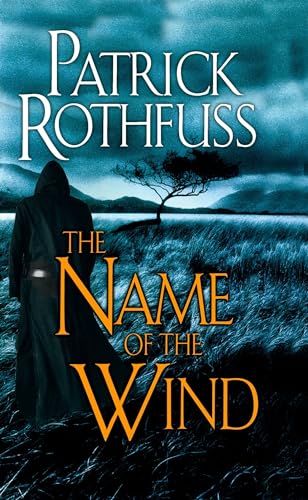Ah, The Name of the Wind by Patrick Rothfuss! What a journey! This review is more than a nod to fantasy lovers; it’s a peek into Kvothe’s life. Full of magic, music, and mischief, Rothfuss crafts a story richer than my grandma’s chocolate cake. Kvothe’s path is complex. He juggles life with flair and flaws. The world-building is another layer of brilliance. Rothfuss paints each scene with both vibrant colors and intricate details. At times, the descriptions could rival my uncle’s long-winded tales at family dinners. Then, there’s the magic itself, a blend of science and mystery! The storytelling is like a weaving loom: patient and intricate. Perfect for those who enjoy a slow dance of words. But, let’s not sugarcoat everything; some might find the pace a tad leisurely. Stay tuned for my full take on the highs and lows of this epic tale!
In a nutshell
‘The Name of the Wind’ by Patrick Rothfuss is a fantasy novel that kicks off the Kingkiller Chronicle series. It’s a coming-of-age story wrapped in mystery and magic. This book introduces Kvothe, a gifted and troubled individual with a knack for music and sympathy (a kind of magic).
Rothfuss weaves a tale filled with adventure, friendship, and heartache. Themes of resilience, identity, and the pursuit of knowledge dance through the pages. There’s also a sprinkle of romance, just enough to keep things interesting without turning into a cheesy love story.
The novel’s structure is unique, using a story-within-a-story format. It keeps you guessing and engaged, making it hard to put the book down. The world-building is immersive, too, with detailed descriptions that let you smell the taverns and feel the chill of the winter wind.
Overall, ‘The Name of the Wind’ is perfect for those who enjoy a well-crafted fantasy with complex characters, a richly detailed world, and a narrative that unfolds like a good yarn told by the fire.
Kvothe’s Journey: From Boy to Legend
Oh, Kvothe! What a character! Reading about Kvothe’s character development in The Name of the Wind feels like watching a flower bloom in the middle of a desert. In the beginning, he’s just a young boy with a big talent and even bigger dreams. Kvothe grows up performing in his family’s traveling troupe, where his talent as a musician blooms. But, sadly, his life takes a tragic turn when a mysterious group called the Chandrian wipes out his family. I remember reading this part and feeling like a piano had dropped on my head – unexpected and quite the shocker!
As Kvothe flees from the trauma, he grows up on the streets, learning the rules the hard way. This part of his development had me reminiscing about my first job at a fast-food joint. Harsh, stinky, and definitely character-building! His resourcefulness and desperation to survive add such depth to his character. Then, oh boy, does he rise! Kvothe enrolls at the University, where he learns magic, also known as ‘sympathy’. Through his adventures and mishaps, Kvothe’s intelligence, curiosity, and determination shine – sometimes getting him into more trouble than he bargains for. But hey, that’s what makes the story gripping, right?
Throughout the novel, Kvothe’s development is portrayed with such complexity. He’s not just a talented musician or a promising student of sympathy; he’s a haunted boy driven by the need to uncover the truth behind his family’s murder. This mix of talent and trauma will keep you turning the pages faster than a Ferris wheel on a sunny day.
Moving on, let’s explore how Patrick Rothfuss wove the detailed tapestry of the world Kvothe inhabits.
Immersive World-Building and Enchanting Settings in ‘The Name of the Wind’
Patrick Rothfuss crafts a world so vivid in ‘The Name of the Wind’ that it almost leaps off the pages to give you a little nip on the nose. I felt like I could smell the smoke from the flickering bonfires and taste the ale at the Eolian. Each setting is detailed enough that it should come with a map and a pair of hiking boots.
The story takes place across different regions, each with its own distinct flavor. We journey through bustling cities, idyllic countryside, and foreboding forests. I could practically hear the wind whispering secrets amongst the leaves, hinting at the name of the wind itself—a secret I’d expect the pro-wind-whisperers to keep close to their chest.
Rothfuss’s attention to detail is stunning. I enjoyed the University setting; it brought back memories of my own college days, though, with significantly less magic and more ramen noodles. It’s a place where knowledge feels like the ultimate treasure, with its vast library and intriguing classes. I found myself wishing I could enroll—until I remembered my old student loans.
However, the descriptions can sometimes feel a bit long-winded. They may test the patience of folks who prefer laser-paced action over poetic prose. But hey, it’s not every day you get to live in a world with such carefully drawn lines.
In the next section, we’re about to jump right into the wonderfully complex realm of the book’s magic system—grab your spell books and wizard hats!
The Magic System: A Spellbinding Tale
The magic system in The Name of the Wind is nothing short of fascinating. Patrick Rothfuss gifts us with a unique blend of science and mystery through ‘sympathy.’ It’s less ‘abracadabra’ and more a physics class with a whimsical twist. Kvothe, the protagonist, navigates this system in a way that makes you believe he’s a magical Einstein in training.
This magic relies on logic, a bit like when my brother tried to convince me that the moon was made of cheese. The energy conservation principle and logical links make for a believable system where nothing comes without a cost. It’s intriguing, and you find yourself wanting to fist bump Rothfuss for such creativity.
Then, there’s the legendary name of the wind itself. Kvothe’s quest to learn this elusive name adds layers to the plot and keeps you on the edge of your seat, much like waiting for a pizza delivery during a game night. It’s enigmatic, it’s significant, and it holds the promise of immense power. Just like my Aunt Sally’s mystery lasagna—the name of the wind is something everyone wants to decipher but only few ever do.
However, the magic’s intricate details might bog down some readers who prefer less exposition. Yet, it shines for those who enjoy dissecting the mechanics of fantasy realms.
Up next, we’ll chat about how Rothfuss weaves his stories and paces the narrative, like a maestro orchestrating a symphony, where every note counts and every pause matters.
Storytelling Style and Pace in ‘The Name of the Wind’
Let me tell you about a time I got so lost in “The Name of the Wind” by Patrick Rothfuss that I nearly missed my bus. Kvothe, our red-haired protagonist, takes storytelling to a whole new level. This guy knows how to spin a yarn!
The book’s structure is like a story within a story. Kvothe narrates his life to a scribe and a silent companion. It’s like when you find yourself binge-listening to your friend’s epic life tale. You just can’t stop. The pace switches between Kvothe’s intense adventures and the quieter moments in the frame story. This change might be jarring for some, like suddenly switching from rock ‘n’ roll to classical music. But, it gives readers a breather.
Rothfuss excels at making every detail count. He’s the kind of writer who won’t just tell you about a dusty road; he’ll make you feel the dust in your nose. Sometimes, though, the pace can slow down. You might think, “Hey, when’s the next big thing happening?” But remember, even the best roller coasters have their slow climbs.
In “The Name of the Wind,” Rothfuss pairs vivid descriptions with Kvothe’s personal flair for drama. It’s like he’s a bard performing for a crowd. And though some readers might find the journey a bit too meandering, it’s worth it for the moments of magic and discovery.
Overall, “The Name of the Wind” is perfect for those who love a detailed and immersive reading experience. Just don’t expect a quick sprint. If you’re into savoring every page, give it a shot!
Conclusion
In wrapping up this review of The Name of the Wind, I can confidently say that Patrick Rothfuss delivers a captivating tale filled with a rich world, a unique magic system, and a character whose development will keep you turning the pages. Sure, some parts may drag a bit with lengthy descriptions, but if you stick with it, you’ll find yourself deeply immersed in Kvothe’s magical journey. This book is a great pick for fantasy lovers who enjoy savoring a story that blends humor, survival, and the quest for identity. Just be ready to invest some time, and remember, watch out for any loose ends—it might leave you wanting more. Now, who wants to start a book club discussion over coffee?


